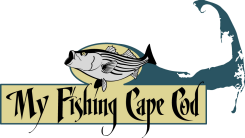Without a doubt nothing beats the excitement of watching a large striped bass crush a top-water plug at the Cape Cod Canal.
However when it comes to consistently catching large striped bass from the "Big Ditch," concentrating on working the bottom of the land cut can pay off in a big way.
However one can not expect to just toss a jig anywhere in the canal and be rewarded with success.

The Cape Cod Canal has its hot spots and dead zones like any other fishing area along the striper coast.
Being able to find the dramatic drop-offs, underwater humps, rocky ledges and relentless rips is key to consistently taking big bass off the bottom.

Striped bass flock to areas of structure like bees to honey. Often times the fish will position themselves deep in a hole, or right behind a rock ledge.
The structure breaks up the swift current, basically in the same way a building blocks a stiff breeze. Just take a look at this sonar screenshot I took while driving my boat through the Canal.
Traditional striper theory states that cow stripers will use current blocking pieces of structure to gain a competitive advantage on their prey. The strong Cape Cod Canal current pushes all sorts of bait and prey items downstream.
Crafty striped bass will take position behind a piece of structure, and then ambush prey as it tumbles in the current.

What this means for the angler is that being able to offer a well placed jig right around, or better yet, directly in these pieces of structure will increase your catch rate.
Often times jigs that bounce just a few yards too far from these hot spots are completely ignored by the bass.
So how do we go about locating these prime jigging spots in the first place?

One of the easiest ways to find areas worth jigging is to cruise through the canal in a boat and look for actual "holes" using sonar. I have done this several times in my boat and it has always paid off.
If you don't own a boat, then another method of locating holes is to pay close attention to differences in the surface water of the canal. Fish holding pieces of structure will often create disturbances in the natural flow of the current.
More than likely clues to the location of the fishy structure shows itself as a wake, ripple, whirlpool etc. on the surface of the canal.
Walking the banks of the canal, or better yet riding your bike along the service road, and keeping a close eye out for differences on the canal's surface is a good way to at least get an idea of where to fish.
Standing waves are arguably the most tell-tale sign of an underwater hump or gulley. Here's a photo of standing waves taken at the rips of Monomoy. You may see similar standing waves in sections of the canal when the current is really ripping. These are always good places to try jigging.

If you find an area with standing waves, the actual fish holding structure will be located slightly up current of the waves. This holds true regarding any sort of disturbance on the surface-the fishy structure will always be slightly up current.
It is now time to zone in on the exact location of the structure. This can be done by fan casting an area with a heavy jig or bank sinker. I typically start with 4 ounces and go heavier or lighter depending on current conditions.

Cast up current and keep a close count on the number of seconds it takes the jig to reach bottom. Obviously the shallower the water, the quicker the jig will reach bottom-the deeper the water, the longer.
For example, one fantastic canal jigging spot that I frequent each May and June features a tall prominent peak followed by a deep, steep hole. It takes my jig 7 seconds to hit bottom on top of the peak. However when cast directly into the deep hole, it takes my jig 20 seconds to reach bottom.

Due to the difference in the amount of time it takes my jig to reach bottom, I know that I am successfully presenting my offering smack dab in the middle of the strike zone.
Fan casting an area will be easiest during the last part of the west tide, slack tide, and the beginning of the east. This is when there is the least amount of water in the canal.

In conclusion, the Cape Cod Canal is littered with fantastic jigging spots. However it can take considerable time and effort to locate the best areas.
Yet if consistently pulling big bass from the canal's bottom is important to you, then the time spent uncovering these prime jigging spots will be well worth the time and energy required to locate them.
For more helpful canal information and updates, please be sure to visit our canal forum which has been very active so far this 2020 season.
Tight lines!






Hey Ryan,
do you have a canal fishing spots map in digital version? I am planning to visit the Canal AUG 3-5 weekend and am traveling from Canada .
If you could please msg me any tips for the upcoming weekend that would be great
Hey Durvesh!
For a time I did have a digital version but it got messed up during a Google update and I haven’t been able to get it working properly again. What I can provide is this map which is a hard copy but also highlights a lot of the best areas.
As Ryan Points out the canal offers more then you can ever imagine learning about in a single season. The low and high points along the edges for example can be very deceiving and for me the best way is to obtain a canal map or even a Gbs Map that in some cases will provide some early hints of what to look and feel for as you let your jig slide along the bottom with the moving current .
To learn where the holes are inside the big river , one of the best ways is to learn how to chunk fish with bait , especially the in close places that one does not need to be a long distance caster to find. AS Ryan pointed out look for the changes of the current with in a specific area and also the back water currents you observe . They can be as close as a few feet from where you are standing or further out in some case with in the long distance range. Another reason to get yourself proficient in casting for not only accuracy, but distance with a lead head buck tail or plug.
Learn how to fish each location at all levels of water incoming or outgoing , when high when low. Also learn when to be there during the stealth times , early morning or early evening . make a log of each venture and eventually you will garner enough to help make your day a little more productive. peace and Prayers
Great tips Carl. Thank you for your comment! I hope you and your wife have a nice July Fourth Holiday. Peace and Prayers!
Thanks for the information. I need all the help I can get to figure out how to fish the canal.
My pleasure! Also, people often ask me about canal maps, so I figured I would provide you with this link to a map of some of the better known spots.
Hey Ryan been fishing the canal not much luck. What is your secret to the good spots to try and low tide high tide slag tight please
Hey Manny – if you’re interested in learning some of the most famous spots, then pick up this chart. It outlines a lot of productive areas, but by no means is this ALL of the productive areas. We also have a 10% off discount code for the chart which you can see by visiting your Account page.
I Ben fishing 30 year s in canal ther were some good points
Great article
great article thanks for posting more great info..stay safe tight lines
Thanks for reading and commenting Will. Tight lines! ?
GREAT ARTICLE. LOOKING FORWARD TO MY NEXT CANAL BIKE RIDE.
Glad you found the article useful Dan. Gluck down there!
This is a great post. I think I remember some of it from a post you did a few years ago, which helped quite bit. The canal is a unique fishing environment, to the point where most canal rats have a special bike, rod, reel, plugs, jigs, leaders, and tears. Just for the ditch.
Nice post!
Glad you enjoyed the post Warren! I hope you are doing well and are able to get back to your Truro fishing grounds soon. Thanks as always for following along with MFCC! ??